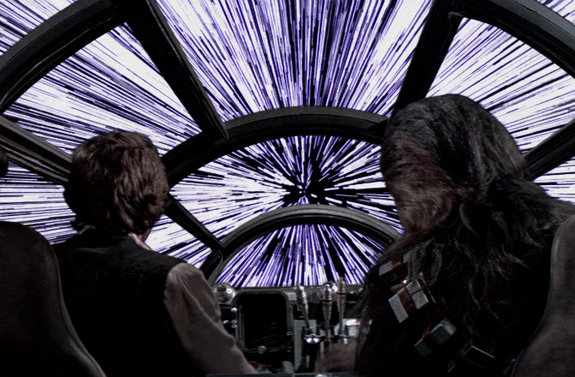
Hyperspace travel is the premise that it’s possible to travel at speeds faster than that of light when energy from other dimensions is harnessed, and is an idea much used by science fiction writers. One famous example is “Star Trek,” where the starship Enterprise jumps from star system to star system to visit other planets.
“If Captain Kirk were constrained to move at the speed of our fastest rockets, it would take him a hundred thousand years just to get to the next star system,” said Seth Shostak, an astronomer at the Search for Extraterrestrial Intelligence (SETI) Institute in Mountain View, Calif, in a 2010 interview with Space.com’s sister site LiveScience. “So science fiction has long postulated a way to beat the speed of light barrier so the story can move a little more quickly.”
But in reality, the concept is “a lot of hype,” Shostak said.
The concept of hyperspace travel is also known as hyperdrive, subspace and warp speed.
But the dearth of research and scholarly discussion on the transportation method make it more often a convenient literary device than scientific possibility, Shostak said.

The Millennium Falcon spaceship makes the “jump to light speed” in the movie Star Wars Episode IV: A New Hope.
Credit: 20TH CENTURY FOX
Other dimensions
Physics suggests that shortcuts through space do exist, Shostak said. The curved nature of space was first proposed by Einstein, and quickly led to the idea of a wormhole : a portion of space that curves in on itself, connecting two otherwise distant parts of space. A spacecraft could theoretically skip ahead to a distant region of space if it enters such a wormhole between the two locations.
As in our familiar universe, objects in a wormhole would have to travel slower than the speed of light , which, in a vacuum is 186,282 miles per second (299,792 kilometers per second). But, a spaceship could appear to have exceeded this limit by traveling through a wormhole and reaching a star system thousand of lights years away in a matter of hours, for example.
However, our access to these inter-space freeways would be limited by the size of the portal.
“Wormholes, we think, are made all the time on a microscopic level,” Shostak said. “But the question is, can we actually use them for transportation?”
Finding or creating a wormhole that’s going to the right place and scooting through it before it closes up and smashes one to pieces are two unsolved problems that the laws of physics don’t clearly bar or allow.
Technically, it would be possible to warp space to create wormhole if one could place a very dense piece of mass in front of their rocket ship, Shostak said. Perhaps similar to the “hyperspace engine” seen in the Star Wars movies, the object would distort the shape of space around it, essentially bringing the chosen destination closer to the ship. But the object would need to have the density of the center of a black hole in order to work.
“The problem is, where do you get the black hole and how do you get it in front of your spacecraft?” Shostak said. “It’s sort of like, how do you create something that will warp space and then put it in front of your spacecraft?”
What about teleportation?
A related science fiction idea is teleportation — the possibility of instantly conveying a person or ship into another part of the universe. The phenomenon is seen in “Star Trek,” where the so-called transporter deconstructs one’s body and reconstructs it at another, distant location.
There is some scientific basis for this idea — scientists have shown that subatomic particles can be moved from one point to another faster than the speed of light, said physicist Ian Durham at Saint Anselm College in a 2010 interview.
But the ability to break apart and reassemble an entire human appears impossible, Durham said. Because of the randomized aspects behind the arrangement of subatomic particles, perfectly reversing them becomes increasingly difficult as they accumulate in greater numbers.
Scientifically looking at hyperspace
While hyperspace is not a current form of space travel, there is ongoing research to determine how viable it is — and what the experience would be like.
In 2013, a group of physics students corrected the view of what happens when spaceships fly at the speed of light. The familiar-to-us streaks of light (seen in “Star Trek,” “Star Wars” and other series) would not actually be the case . Instead, the view would appear more like a centralized bright glow .
The fast travel would cause light to shift into longer wavelengths as per the Doppler effect, which also explains phenomena such as why the sound of a car horn changes before it passes an observer and afterward. In space, humans would not be able to see starlight because its wavelengths would be stretched into the X-ray spectrum. Also, the glow of the universe — which glows in microwaves — would become visible because its light would be stretched into the visible spectrum.
In 2015, rumors of a possible NASA warp drive called the “EM Drive” surfaced on a NASASpaceflight.com forum and then spread around the Internet rapidly. The reports said a prototype of this engine, which was intended to operate without fuel and move faster than light, produced a small amount of thrust when tested in a vacuum. Critics said it would violate physical laws.
When contacted by Space.com, however, NASA officials downplayed the research . “This is a small effort that has not yet shown any tangible results,” they said. “NASA is not working on ‘warp drive’ technology.”
Additional reporting by contributor Zoe Macintosh.
Additional resources
Comments are closed.